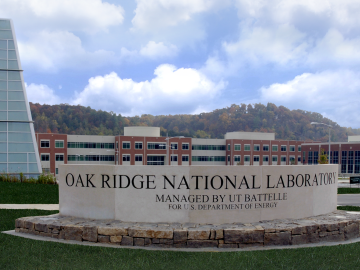Filter News
Area of Research
- (-) Functional Materials for Energy (3)
- (-) Nuclear Science and Technology (9)
- Advanced Manufacturing (8)
- Biological Systems (3)
- Biology and Environment (8)
- Building Technologies (2)
- Chemistry and Physics at Interfaces (3)
- Clean Energy (60)
- Computer Science (2)
- Energy Frontier Research Centers (4)
- Fusion and Fission (1)
- Fusion Energy (2)
- Geographic Information Science and Technology (1)
- Isotope Development and Production (1)
- Isotopes (1)
- Materials (64)
- Materials for Computing (3)
- Materials Synthesis from Atoms to Systems (2)
- Materials Under Extremes (3)
- National Security (5)
- Neutron Science (23)
- Quantum Condensed Matter (1)
- Quantum information Science (1)
- Reactor Technology (1)
- Supercomputing (35)
- Transportation Systems (2)
News Type
Media Contacts

The combination of bioenergy with carbon capture and storage could cost-effectively sequester hundreds of millions of metric tons per year of carbon dioxide in the United States, making it a competitive solution for carbon management, according to a new analysis by ORNL scientists.

After its long journey to Mars beginning this summer, NASA’s Perseverance rover will be powered across the planet’s surface in part by plutonium produced at the Department of Energy’s Oak Ridge National Laboratory.

Juergen Rapp, a distinguished R&D staff scientist in ORNL’s Fusion Energy Division in the Nuclear Science and Engineering Directorate, has been named a fellow of the American Nuclear Society

Researchers at the Department of Energy’s Oak Ridge National Laboratory are refining their design of a 3D-printed nuclear reactor core, scaling up the additive manufacturing process necessary to build it, and developing methods

OAK RIDGE, Tenn., Feb. 19, 2020 — The U.S. Department of Energy’s Oak Ridge National Laboratory and the Tennessee Valley Authority have signed a memorandum of understanding to evaluate a new generation of flexible, cost-effective advanced nuclear reactors.

Jeremy Busby, director of the Reactor and Nuclear Systems Division at the Department of Energy’s Oak Ridge National Laboratory, has been elected fellow of the American Nuclear Society for his contributions to developing materials for nuclear energy

With the production of 50 grams of plutonium-238, researchers at the Department of Energy’s Oak Ridge National Laboratory have restored a U.S. capability dormant for nearly 30 years and set the course to provide power for NASA and other missions.



Less than 1 percent of Earth’s water is drinkable. Removing salt and other minerals from our biggest available source of water—seawater—may help satisfy a growing global population thirsty for fresh water for drinking, farming, transportation, heating, cooling and industry. But desalination is an energy-intensive process, which concerns those wanting to expand its application.




